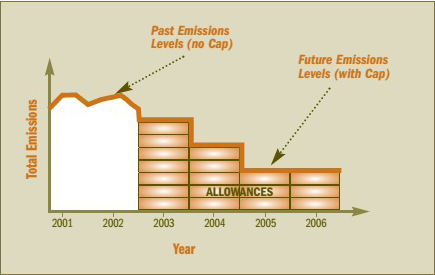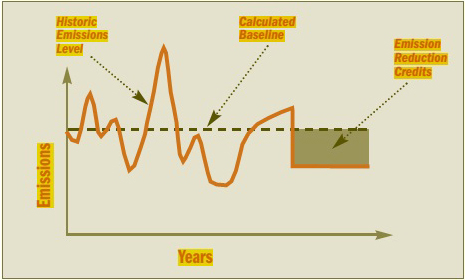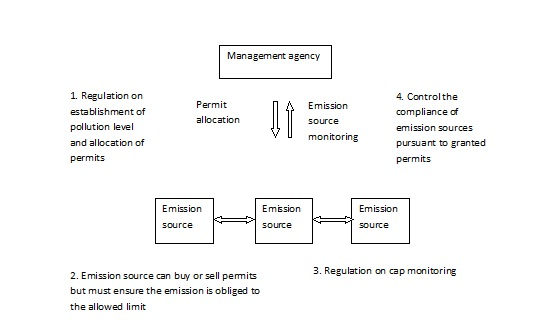

27/06/2016
Emission quota is a market-based policy tool to help emission owners implement emission reduction at lower costs compared to other traditional pollution control methods. This tool is first proposed by the Canadian economist John Dales in 1968 at Toronto University and first applied in 1977 according to the Clean Air Act of America. This market model has been studied and successfully applied in reality in some countries such as the USA, Canada, Australia, China, etc.
With this new management tool, management agencies only need to pay attention to the total volume of emissions that are discharged to the environment without paying attention to single emissions from separate emission sources.
1. Classification of emission markets
In the last decade, some emission market models have been developed. In general, there are two basic types of emission markets which are cap and trade scheme and baseline and credit scheme.
Cap and trade is the foundation of the emission trading scheme. This market works based on the approach that management agency will establish an overall cap and allocate emission allowances to pollution sources as permits. The government identifies the maximum amount of emissions allowed for discharge to the environment, then allocates to pollution sources through granting permits called pollution quotas and the total number of permits is not higher than the allowed emission limit. Sources which want to increase emissions to the environment but their emissions exceed the amount stated in the permits have to buy and trade with other sources that have less emissions and still have the right to emit to the environment. The number of permits is equal to the emission allowances. Relevant stakeholders can buy and trade permits directly through a common market.
 |
| Figure 1: Classification of emission markets |
Baseline and credit market is a voluntary participation, is an open market for partners, based on the emission market method. Emission reduction credit is developed when companies implement steps to reduce emission below the baseline. The baseline can be calculated in many different ways, mostly using the average emission level. Credit is a unit that can be traded regardless of emission sources.
For example in the trading market of carbon emission reduction credits, one verified emission reduction (VER) is equivalent to 1 tonne of CO2e. One company in Viet Nam, as a result of good environmental management performance, receives the certificate saving of 100 tonnes CO2e, equivalent to 100 VERs. If this company does not use these 100 VERs, it can sell to other companies in the same country or in other countries. Currently, the trading of VER is carried out through contracts signing mostly between developed countries and developing countries. When companies buy these VERs they are allowed to emit a volume equivalent to 100 purchased VERs.
 |
 |
| Figure 2: Cap and trade market | Figure 3. Baseline and credit market |
2. Components of emission market (Basic)
USA is the first country in the world that successfully applies the emission market model in practice. Experience from USA shows that there are 4 special components of the emission trading, including:
Establishment of the optimal emission level: The first and important step of this model is to establish the optimal emission level. The establishment of the optimal emission level depends on the calculation of the total pollution load of the calculated area. Current load is the amount of pollutants discharged during the analysed time. Target load is the amount of pollutants discharged of each source. For each source, target load will reflect the emission allocation and will be used for state management in order to achieve the allocated load. The total target load is the basis for calculating the number of emission permits and these permits are considered as valuable assets.
The total receiving volume of the basin is usually allocated based on calculations to meet standards of wastewater concentration and standards. For non-point sources, the total receiving volume lacks of information on sources, the estimates are selected for calculation in each river basin. In addition, information on agriculture and other activities in the area will be necessary for estimating the general pollution load.
Formulation of permit allocation: The total emission volumes are divided into units called emission permits, with each emission permit is equivalent to one unit (usually one tonne). Common parameters reflecting pollution such as BOD (biological oxygen demand) and COD (chemical oxygen demand) are regulated to control the emission level of water sources. In addition, some other pollution parameters relating to water quality status of the receiving waters are studied. Emission permits will be distributed for market stakeholders to ensure equity and transparency. It is necessary to use formulas to identify the number of permits received by each emission owner. Some studies show that using the social effectiveness method, the pollution reduction marginal damage cost as a criterion to decide the number of permits is a full scientific approach. Some others agree with the opinion that the allocation of permits depends on pollution levels or impacts to the environment caused by each enterprise and emission source. Currently, programs being implemented in some countries still apply these two methods for allocation of emission permits.
Implementation monitoring: Emission volumes from factories, emission sources must be regularly checked and monitored with the participation of all relevant stakeholders. To operate the emission permit market, relevant stakeholders and local authorities play important roles, particularly the role of management agencies in monitoring, inspection and assessment of emission volumes of enterprises is very critical.
Legal framework: The program that wants to succeed must have solid legal foundation to ensure enterprises, factories, sources participating in the markets believe that the purchase of emission permits is the only way to meet obligations on environment. In addition to ensuring the program to achieve the set target, management agencies need to develop specific legal regulations on permit management, permit valuation mechanism, market stakeholders or permit ownership right, etc. These contents need to be specified in legal regulations to ensure effective and transparent operation of emission quota trading market.
 |
| Figure 4. Component of emission market model |
3. Mechanism of permit trading of the market
Emission market is the transfer of emission permit or emission reduction credit among different sources. Two basic aspects affecting the transaction mechanism of these papers are the diminishing marginal cost and the market value of the permit. These two aspects are important to the best decision making process with commitments of enterprises, factories and emission sources.
Table 1. Similarity and difference between two markets
|
CONTENT |
PERMIT MARKET |
CREDIT MARKET |
|
Name |
Cap and trade |
Baseline and credit |
|
Transaction unit |
Permit |
Credit |
|
Emission limit |
Total emission volume |
Baseline |
|
Scope |
Limit the participation of enterprises, industrial units. |
Open program to emission sources |
|
Management cost |
Low |
High |
The purchase of permits among pollution sources is the nature of the emission market. The core issue of the purchase of permits among pollution sources is the difference of marginal abatement cost. Marginal abatement cost of the pollution source depends on technology level as well as characteristics of pollutants discharged to the environment. Enterprises having advanced technology equipment will have lower emission reduction cost compared to enterprises having backward technologies or different pollutants will lead to different pollution reduction cost. Marginal abatement cost curve will provide information on the increase cost per one emission unit. If the marginal abatement cost of factories and pollution sources is similar, there is no foundation for exchange and transaction. At all times, market stakeholders will compare the marginal abatement cost and decide the trading of permits.
Three scenarios can be developed: natural emission volume equal to the number of granted permits; the actual emission volume larger than the number of granted permits: emission volume must be equal to the number of granted permits. Therefore, in this case emission trading is carried out; emission lower than that in the allocated permit: selling the permit.
4. Principles for emission markets
Environmental integrity: Emission markets support to control the environment according to targets set by management agencies.
Economic effectiveness: Air emission market supports to achieve environmental targets at lower costs.
Transparency: The public has the right to know the performance of the market, allowing the market to assess the market information.
Equity: Ensure the equity among companies, enterprises, regions to achieve the emissions as regulated.
5. Conclusion
The study and implementation of emission markets, particularly emission permit markets in Viet Nam is on its initial period, we only start to join the baseline and credit through some cooperation projects. In the future, Viet Nam needs to promote the research and application of this tool, develop appropriate and feasible policy mechanism, study and then pilot the emission permit market in different areas, such as industrial waste market, to support state management on environment in general and wastewater environment in particular to be more effective.
MSc. Bùi Hoài Nam
MSc. Hàn Trần Việt
Institute of Environmental Science, Vietnam Environment Administration